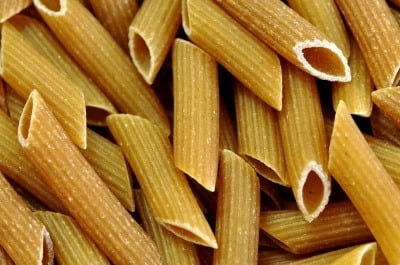
A blessing and a curse to be honest when it comes to pasta!
If it’s about preserving colour over shelf-life or ensuring the consumer enjoys a well-cooked pasta dish which actually looks a pale straw- brown colour, there is a right time and place for browning to enhance sensory appeal. Whilst this is not a piece on non-enzymatic browning which is another issue, but on the enzymically derived form of this colour, browning in various foods often develops and needs careful controlling.
Browning Enzymes – PPO and Peroxidases
The enzymes responsible for browning in foods are the polyphenoloxidases (PPOs; EC 1.10.3.1) and their associated catalysts, the peroxidases (EC1.11.1.7) which generate substrates that lead to further browning (Baik et al., 1985; Kruger et al., 1992). It’s true to say that all grains and fruits should have polyphenoloxidases but not all have been found – blackcurrants being an example. In strawberry, it is highly troublesome and if active will cause a beautiful red-scarlet juice to slowly turn a watery beige overnight, if left untreated.
Wheat PPO is an issue in baked goods because it causes unnecessary and uncontrolled browning especially in noodles, pasta, chapattis, breads etc. (Baik et al., 1995; Hatcher et al., 1999; Kruger, 1994; Miskelly, 1996; Morris et al., 2000). Generally, pasta colour needs to be a pale yellow whilst instant noodles need to be as clean and as pale as feasible. PPO activity has been profiled both during growth, and processing to flour. Activity is highest in the immature kernel but declines with maturation (Kruger, 1976). At the genetic level, mapping of the wheat genome (Demeke et al., 2001) revealed at least three different PPO genes in wheat grain.
Anti-Browning Agents
It may be possible for anti-browning additives to suppress the enzyme activity or minimise the supply of substrates for reaction. Not surprisingly, milled and treated flour usually retains only about 3% of its total PPO activity after processing of the wheat grain (Baik et al., 1994). The bran layer however can retain high levels of activity in the mature kernels (Milner and Gould 1951; Okot-Kotber et al., 2001). Whitehurst and Van Oort (2010) make an intriguing comment that other unknown mechanisms are also involved – this may be due to peroxidases however.
Given there is a genetic element to PPO activity, it must also be feasible to breed wheat varieties with ever decreasing amounts of enzyme activity or have it suppressed throughout wheat growth. There are however consequences because there is recent evidence that PPO protects the wheat plant from diseases and viruses (Melo et al., 2006; Yamasaki et al., 2008), and if it inhibits trypsin activity could protect the plant from insect and herbivore damage, so suppression of the gene is probably not to be the way forward. The wheat PPO has also been examined (Demeke and Morris, 2002) which would allow further molecular investigation to identify factors which might control its browning activity once processed.

The common inhibitors of browning have been sulphites, ascorbic acid (even though at high concentrations it is a pro-oxidant) and phosphates for whitening flour. Ascorbic acid is used commercially to retain the yellow colour in dried spaghetti (Milatovic, 1985). Denaturation of PPO using proteases (Luo and Patterson, 1994) and with modified atmospheric packaging (Faulkner, 1989). PPO itself is a heat labile enzyme so can be inactivated easily using a rapid heat treatment at 70-90°C. (Vamos-Vigyazo, 1981). A short microwave treatment of wheat grains produced a milled flour which retained less than 10% of its PPO activity (Yadav et al., 2008).
If you have other ideas for reducing browning in pasta I’d be interested to hear. Likewise, if you want to find out more about browning reactions in a host of foods then please give me a call (0044 7714101039) or e-mail (awss@foodwrite.co.uk).
N.B. Post contains links to our affiliate marketing partner. Please read our affiliate disclosure.
References
Baik, B.-K. (1995) Discoloration of dough for oriental noodles. Cereal Chem. 72 pp.198–205
Demeke, T. and Morris, C. (2002) Molecular characterisation of wheat polyphenol oxidase (PPO) TAG Theor. Appl. Gen. 104 (5) pp. 813-818
Hatcher, D.W. (1999) Measurement of time-dependent appearance of discolored spots in alkaline noodles by image analysis. Cereal Chem. 76 pp. 189–194.
Kruger, J.E. (1994) A whole seed assay for polyphenol oxidase in Canadian prairie spring wheats and its usefulness as a measure of noodle darkening. Cereal Chem. 71 pp. 324–326.
Kruger, J.E., Matsuo, R.R., and Preston, K. (1992) A comparison of methods for the prediction of Cantonese noodle colour. Can. J. Plant. Sci., 72 pp. 1021-1029
Melo GA, Shimizu MM, Mazzafera P (2006) Polyphenoloxidase activity in coffee leaves and its role in resistance against the coffee leaf miner and coffee leaf rust. Phytochemistry 67 pp. 277-285.
Miskelly, D.M. (1996) The use of alkali for noodle processing. . In: J.E. Kruger et al. (ed.) Pasta And Noodle Technology. American Association of Cereal Chemists, Inc., St. Paul, MN. pp. 227–272
Morris, C.F. (2000) Effect of processing, formula and measurement variables on alkaline noodle color—toward an optimized laboratory system. Cereal Chem. 77 pp. 77–85.
Vamos-Vigyazo, L. 1981. Polyphenol oxidase and peroxidase in fruits and vegetables. CRC Crit. Rev. Food Sci. Nutr. 15 pp. 49.
Yadav, D.N., Patki, P.E., Sharma, G.K. and Bawa, A.S. (2008) Effect of microwave heating of wheat grains on the browning of dough and quality of chapattis. Int. J. Food Sci., Technol. 43 (7) pp. 1217-1225
Whitehurst, R.J. and Van Oort, M. (2010) Enzymes in Food Technology. 2nd edt. John Wiley & Sons. Chichester. UK. Pp. 148-149
Yamasaki, Y., Konno, H., and Noda, K. (2008) polyphenol oxidase from wheat bran is a serpin. Acta. Biochimica Polonica. 55 (2) pp. 325-328
My partner and Istumbled ovwr here different web page and thought I might
check things out. I like what I see so now i am following you.
Look forward tto goinng over your web page for a second time.
I’ve always wondered why my fresh pasta at home has always gone a dull brown colour. I noticed it turns a strange brown colour when I use a particular tap but I cant believe its my water supply. Would you have any other ideas to help me get a better colour ?
Muchos Gracias for your blog post. Awesome.
I’ve often wondered why my pasta turns a beige brown color with drying. I make loads at home and the dough is always as white as it could be especially if I use the really hard flour like the Tipo00. I think it must be those enzymes you bang on about but I also know that when I dry it in the sun it goes even darker.